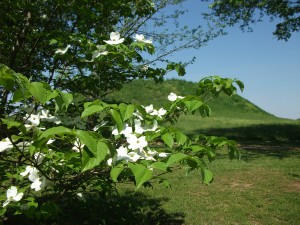Responsibility & Redemption: Etowah Indian Mounds
On-Site Lightwork, Pilgrim's Progress Add comments4/22/10
Today I visited the Etowah Indian Mounds, a native city-state dating from about 700 A.D. to 1500 or so A.D., reaching its peak around 1350. This was once a thriving city with as many as 2,000 people in permanent residence. The decline of the city began when Hernandez DeSoto, the Spanish invader (who history kindly calls an “explorer”), came through and, though their numbers were greater, the natives could not overcome the advanced weapons and horsed soldiers of the Spanish. The French followed the Spanish, followed by yet other Europeans, bringing diseases that decimated the natives while continuing to attack and harass them until the indigenous residents had no choice but to abandon their homes, fleeing to the swamps and other inhospitable lands in the region. Separating by agreement in order to keep competition for resources to a minimum, their way of life was forever lost as they became hunters and trappers, adapting to the “white man’s” ways by trading the skins and furs of their hunt for beads and blankets and, eventually, guns.
 I didn’t need to walk around and sense the energy here. Before I had even begun, I perceived strongly the trauma that the people of this place had experienced. I walked therefore straight through the middle of what was once the main plaza to the back of the complex where it abuts the river, seeking an appropriate spot to do my work. There was a beautiful park there, with benches and a lovely swing, in which I sat for awhile, enjoying the flow of the Etowah River. It has quite a strong current and it carries you along, out of the ordinariness of your everyday cares. The spirit of the place is sweet and, if you are attuned to nature, it will usher you into an altered state. A goose visited briefly. I communicated with him, collected wildflowers, and admired the trees while listening to Spirit as to why I was there and what I was to do. I was aware of a sadness in me for the loss of this and so many other indigenous civilizations, and the guidance came to me to take responsibility for my race.
I didn’t need to walk around and sense the energy here. Before I had even begun, I perceived strongly the trauma that the people of this place had experienced. I walked therefore straight through the middle of what was once the main plaza to the back of the complex where it abuts the river, seeking an appropriate spot to do my work. There was a beautiful park there, with benches and a lovely swing, in which I sat for awhile, enjoying the flow of the Etowah River. It has quite a strong current and it carries you along, out of the ordinariness of your everyday cares. The spirit of the place is sweet and, if you are attuned to nature, it will usher you into an altered state. A goose visited briefly. I communicated with him, collected wildflowers, and admired the trees while listening to Spirit as to why I was there and what I was to do. I was aware of a sadness in me for the loss of this and so many other indigenous civilizations, and the guidance came to me to take responsibility for my race.
And so I found a sweet spot to lay myself upon the ground near one of the two major mounds there. I drew in energy of earth and sun, grounded myself, put up protection. I opened myself, sending out love to all the spirits of the place. When I felt I had the spirits’ attention, I began to apologize in humility to the ancestors of that place — for the ignorance, cruelty, and callousness of “my” people. I pulled in as much light as I could and sent out love to everything: all of nature there, the earth, the sky, the elemental spirits, the ancients… all the way out into space.
Having finished, I headed back across the plaza. As I did so, I could visualize the life there: adults having sporting competitions, the children playing and learning new skills, people trading with visitors from other villages and regions. Again I was overcome with a sense of grief at the destruction of their way of life. “I’m so sorry,” I whispered once again, “so sorry.” To which a voice replied, “Change happens, little sister.” And in that simple word, I felt acceptance. Not just for myself by the ancient ones, but for all the ways things come and go, begin and end. And so I left there in great gratitude and humility for forgiveness and the lesson.
October 1st, 2016 at 10:07 am
No epidemiological studies or case reports investigating the association of exposure to cancer risks
in humans and Garcinia cambogia extract were identified in the available literature.
October 1st, 2016 at 1:51 pm
I suspect Dr. Oz will express shock (shock!) that some terrible performer out there would mistreat people’s trust, and the Senator will bask in the attention his celebrity brings to CSPAN.
October 1st, 2016 at 5:23 pm
I recommend it to anyone needing help with the cravings
witch will help with weight loss.
October 1st, 2016 at 7:24 pm
Citrin is the name given to the calcium salt of HCA extracted from the Garcinia cambogia fruit.